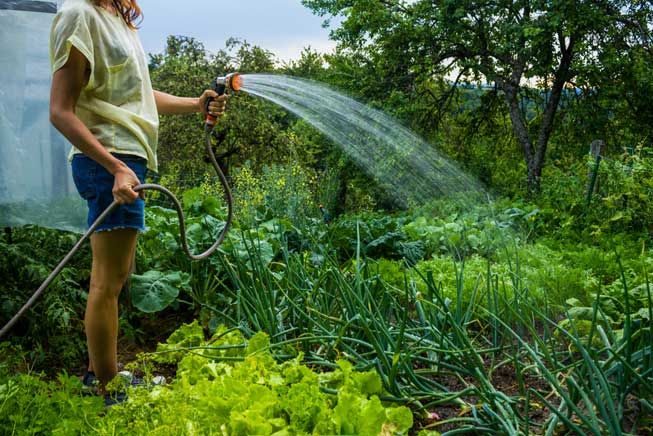
Everyone knows vegetables need water to grow. What they might not know is that vegetables need adequate water even after the plants have set fruit. Vegetables, after all, are mostly water. Consider, for example, the water content of these commonly grown vegetables:
- Cucumbers and and lettuce: 96 percent
- Zucchini, radish and celery: 95 percent
- Tomatoes: 94 percent
- Green cabbage: 93 percent
- Cauliflower, eggplant, red cabbage, peppers and spinach: 92 percent.
- Broccoli: 91 percent
- Carrots: 87 percent
- Green peas and white potatoes: 79 percent
“I think a lot of people forget that a vegetable is really just vegetable-flavored water, and they neglect the water part of growing backyard vegetables,” said Dani Carroll, a regional extension agent with Alabama Extension who specializes in home environments, gardens and pests. Carroll offered the tips below to help backyard gardeners ensure they are watering their vegetables correctly so all of the effort they put into their gardens doesn’t go to waste. These guidelines apply to winter and fall gardens as well as spring and summer gardens.
Watering do’s:
Water an inch per week. “This is a really good guideline,” Carroll said. To help homeowners understand how to calculate how much water is needed to achieves this goal, she said “an inch of rain is 60 gallons per hundred square feet.”
Use a rain gauge. This simple device will let you how much rain your garden is receiving and, therefore, how much you need to water.
Collect rainwater. It’s free and even contains beneficial trace nutrients, Carroll said.
Water deeply. Apply water two to three times a week and water deeply each time as opposed to a brief, shallow watering every day. Watering deeply — moistening the soil to a depth of six inches is ideal — will encourage plants to send roots well into the ground. Deep roots help plants better sustain stresses caused by hot and dry weather.
 Your vegetables need about six inches worth of water two or three times a week. (Photo: sima/Shutterstock)
Your vegetables need about six inches worth of water two or three times a week. (Photo: sima/Shutterstock)
Know your soil type. While Carroll really likes the “inch” rule, she says knowing your soil type is critical to ensuring you achieve this goal. “If you have a sandy soil, the water is going to filter right through, whereas a clay soil is going to hold water.” People who have sandy soils, therefore, will need to strive for more than an inch of water a week, Carroll said.
Have your soil tested. Homeowners can send a soil sample to a state extension lab to have it tested to determine its texture. Soil sample kits are available at county extension offices. The results will also include information on the nutrients in your soil. Fees for the service vary by state. The cost is usually very small, but it can save homeowners a lot of money, Carroll pointed out. That’s because knowing your soil nutrient content can help avoid the application of unnecessary fertilizers. “I soil test about every three years,” she said. One reason for that is to know the soil pH. It’s important to get this correct because pH controls how well plants take up nutrients.
Water early in the morning. You’ll lose less water to evaporation by watering before the heat of the day sets in. If you get water on plant leaves, they’ll have plenty of time to dry, which reduces the chance of fungal and disease problems than if you water late in the day.
Use a drip or soaker hose. You can apply water next to the plants where the water will seep deep into the root zones. You will also avoid watering between rows and in walkways, which wastes water and can promote weeds to grow. These are best on even ground. If you have uneven ground, you will likely get too much water at the end of the hose and not enough at the front end.
Use drip irrigation. It’s not just for commercial agriculture! Kits for use in home gardens are available online at very reasonable prices. This is a very efficient way to water because pressurized emitters can be set to water specific areas at pre-set rates. With these kits you’ll know exactly how much water you’re putting on your garden.
 Drip irrigation allows you to control the amount of water your veggies get. (Photo: Ryo Chijiiwa/flickr)
Drip irrigation allows you to control the amount of water your veggies get. (Photo: Ryo Chijiiwa/flickr)
Water by hand. A slow small stream of water is more efficient than a fast stream because a significant amount of water from a fast stream will run off and be wasted.
Use mulch. There are a number of advantages to mulch. An ideal mulch is three inches thick. Leave a space of one-three inches between the base of the plant and the mulch. Mulch mediates the soil temperature, conserves water by preventing evaporation and holds down fungal diseases from rain that can splash fungal spores onto bottom leaves.
Removed leaves that don’t look right. Leaves of vegetable plants, particularly lower leaves, can experience many problems from water. Pull yellow or spotted leaves from the plants and dispose of them away from the garden. “Sanitation is one of the most important aspects of home vegetable gardening,” Carroll said.
Use water-soluble fertilizer if growing vegetables in a pot. If you forget to water the pot, granular fertilizers will just sit there.
Use granular fertilizers in gardens. With drip hoses, you know granular fertilizers will get watered in, Carroll said.
Observe your plants. They’ll let you know if you’re watering them properly. Wilted leaves are just one example of how plants “talk” to us. It’s important to avoid these types of problems because they weaken plants. “I use drip hoses and drip irrigation, and how long I leave them on is pure observation,” Carroll said.
 Keep an eye on both your plants and your soil to maximize your watering efforts. (Photo: Belodarova Kseniya/Shutterstock)
Keep an eye on both your plants and your soil to maximize your watering efforts. (Photo: Belodarova Kseniya/Shutterstock)
Observe the soil. Simply use a spoon or a trowel to see how deeply moisture has penetrated your soil. As mentioned, the ideal depth is six inches. The depth of your moisture will let you know if you’ve watered enough.
Watering don’ts:
Use a sprinkler. Overhead watering can contribute to bacterial and fungal diseases. It can also result in wasted water because you’ll lose a lot of that water to evaporation, you’ll water pathways and rows, which can encourage weeds, and you’ll spray nearby areas that don’t necessarily need the water. “There’s no telling what you’re watering with a sprinkler,” Carroll said.
Water late in the afternoon. The foliage will likely stay wet all night, which can lead to fungal and disease problems.
 Don’t water your vegetables shallowly or too late in the day. (Photo: Kirsanov Valeriy Vladimirovich/Shutterstock)
Don’t water your vegetables shallowly or too late in the day. (Photo: Kirsanov Valeriy Vladimirovich/Shutterstock)
Water shallowly. Daily shallow watering keeps roots near the top of the soil where they can easily dry out and cause the plants to wilt and underperform in producing vegetables. Exceptions are seed beds and transplants. Seeds need constant moisture to germinate and don’t have roots, anyway. Transplants need consistent watering until they are established. Daily watering at first will help reduce transplant shock.
Water too fast. If you’re hand watering with a hose, avoid hitting your plants with a hard stream of water. “Many people think you shouldn’t do this because they’re going to hurt the plants,” Carroll said. That’s not the case, she quickly added. The problem with watering too fast is that you’ll have a lot of water that just runs off and winds up being wasted. Instead, use a steady small stream of water.
Put out granular fertilizers before big storms. People sometimes think it’s a good idea to put out fertilizers before big storms because the rain will soak the granules into the soil. Actually, the opposite can happen. Downpours may wash them away!
3 most common watering mistakes
Carroll said home gardeners often make three mistakes when watering their vegetable gardens.
They love their garden too much. “People think … water, water … it’s wilting! … It needs more water,” said Carroll. “When you water too much, plants will actually get the same symptoms (wilting) as they would if you weren’t watering your plants enough.” The problem with too much water, she said, is that the plant roots can’t breathe. “Roots need oxygen,” she added.
They water shallowly every day. This causes the problems as described above.
 It may be fun to mist your vegetables, but it doesn’t do them any favors. (Photo: gornostay/Shutterstock)
It may be fun to mist your vegetables, but it doesn’t do them any favors. (Photo: gornostay/Shutterstock)
They mist their plants. “This is probably the worst thing you can do because it can spread diseases,” Carroll said. In the Southeast, she pointed out, even in a drought plants can have can have diseases that rely on water to transfer spores from one plant to another because there is so much humidity in the air. Misting plants can contribute to the problem of transferring diseases than can infect and kill plants.







